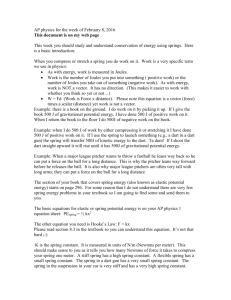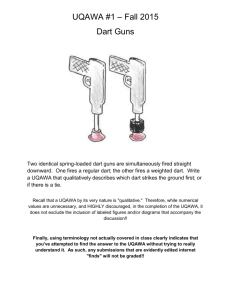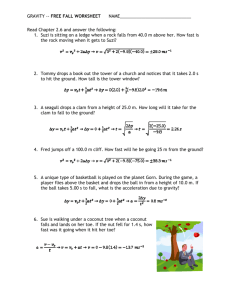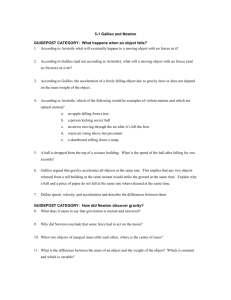Spring Forces Physics Exercises with Solutions
advertisement
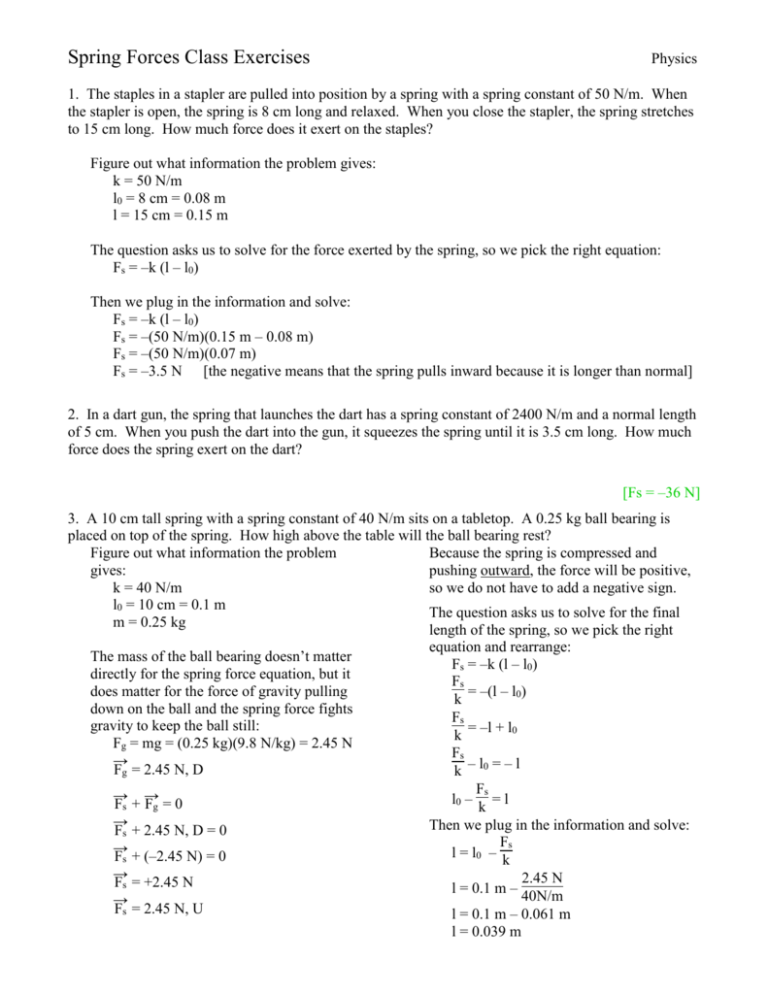
Spring Forces Class Exercises Physics 1. The staples in a stapler are pulled into position by a spring with a spring constant of 50 N/m. When the stapler is open, the spring is 8 cm long and relaxed. When you close the stapler, the spring stretches to 15 cm long. How much force does it exert on the staples? Figure out what information the problem gives: k = 50 N/m l0 = 8 cm = 0.08 m l = 15 cm = 0.15 m The question asks us to solve for the force exerted by the spring, so we pick the right equation: Fs = –k (l – l0) Then we plug in the information and solve: Fs = –k (l – l0) Fs = –(50 N/m)(0.15 m – 0.08 m) Fs = –(50 N/m)(0.07 m) Fs = –3.5 N [the negative means that the spring pulls inward because it is longer than normal] 2. In a dart gun, the spring that launches the dart has a spring constant of 2400 N/m and a normal length of 5 cm. When you push the dart into the gun, it squeezes the spring until it is 3.5 cm long. How much force does the spring exert on the dart? [Fs = –36 N] 3. A 10 cm tall spring with a spring constant of 40 N/m sits on a tabletop. A 0.25 kg ball bearing is placed on top of the spring. How high above the table will the ball bearing rest? Figure out what information the problem Because the spring is compressed and gives: pushing outward, the force will be positive, k = 40 N/m so we do not have to add a negative sign. l0 = 10 cm = 0.1 m The question asks us to solve for the final m = 0.25 kg length of the spring, so we pick the right The mass of the ball bearing doesn’t matter directly for the spring force equation, but it does matter for the force of gravity pulling down on the ball and the spring force fights gravity to keep the ball still: Fg = mg = (0.25 kg)(9.8 N/kg) = 2.45 N → Fg = 2.45 N, D → → Fs + Fg = 0 → Fs + 2.45 N, D = 0 → Fs + (–2.45 N) = 0 → Fs = +2.45 N → Fs = 2.45 N, U equation and rearrange: Fs = –k (l – l0) Fs k = –(l – l0) Fs = –l + l0 k Fs k – l0 = – l Fs l0 – k = l Then we plug in the information and solve: Fs l = l0 – k 2.45 N l = 0.1 m – 40N/m l = 0.1 m – 0.061 m l = 0.039 m 4. Assume that the elastic bands on a slingshot work like a spring with a spring constant of 250 N/m (they actually follow a slightly different, though similar, law than springs). If you have to pull back with 100 N of force to hold the pouch against bands that start out 20 cm long, how long are the bands? [ l = 0.6 m = 60 cm] 5. You get a job with the Acme spring company, calibrating the springs for scales for the supermarket. You test one spring by hanging a 5 kg mass on the end and it stretches from 30 cm long to 45 cm long. What is the spring constant for that spring? Figure out what information the problem gives: l0 = 30 cm = 0.30 m l = 45 cm = 0.45 m The mass of the object doesn’t matter directly for the spring force equation, but it does matter for the force of gravity pulling down on the mass. The spring has to pull upward just as hard as gravity is pulling down, so we know the force the spring exerts if we know the force gravity pulls. Fs = Fg = mg = (5 kg)(9.8 N/kg) = 49 N Because the spring is stretched and pulling inward, the force will be negative, so we have to add a negative sign. Fs = –49 N The question asks us to solve for the force exerted by the spring, so we pick the right equation and rearrange: Fs = –k (l – l0) Fs – (l – l0) = k Fs (l0 – l) = k Then we plug in the information and solve: Fs k = (l – l) 0 –49N k = (0.30 m – 0.45 m) –49N k = (–0.15 m) k = 326.7 N/m 6. Your car is suspended from springs to make the ride softer. If the springs stretch from 20 cm long to 10 cm long when the full weight of your 1000 kg car rests on them, what is the spring constant of the springs? [k = 98,000 N/m]
